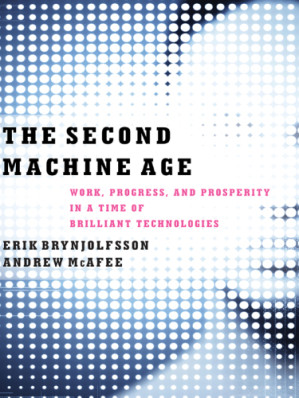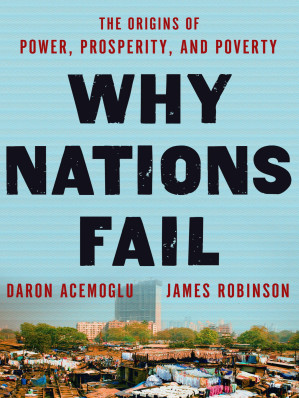Exponential Growth and Digital Technologies
We're entering a second machine age where computers do mental work, not just physical work.

Book summary
by Brynjolfsson & McAfee
Work, Progress, and Prosperity in a Time of Brilliant Technologies
Digital revolution's economic and social effects
Topics
Read one key concept per day and use Readever to track how each applies to your industry or career. After each chapter, log one technology trend you're observing and analyze it through the bounty vs. spread framework. Highlight the authors' policy recommendations and set reminders to review human-machine collaboration strategies. Use Readever's AI to translate economic concepts into practical career and business decisions.
Things to know before reading
The Second Machine Age explores how digital technologies like AI, automation, and big data are fundamentally transforming our economy, work, and society, creating unprecedented opportunities while also presenting significant challenges that require new approaches to education, policy, and business.
The Second Machine Age presents a compelling framework for understanding how digital technologies are reshaping our world through three key phenomena: exponential growth, digitization, and combinatorial innovation.
We're entering a second machine age where computers do mental work, not just physical work.
Digital technologies create unprecedented bounty but also increase inequality.
The best outcomes come from humans and machines working together, not competing.
Ready to continue? Launch the Readever reader and keep turning pages without paying a cent.

Thomas Piketty
Landmark study on wealth inequality and capital dynamics globally

Acemoğlu & Robinson
Nations succeed or fail based on inclusive vs extractive institutions

Adam Smith
Foundational text on capitalism, division of labor, and markets
This summary reveals how digital technologies are creating a new economic era with profound implications for work, education, and society. Learn to navigate the opportunities and challenges of automation, AI, and exponential technological growth.
Key idea 1
We're entering a second machine age where computers do mental work, not just physical work.
Unlike the first machine age that amplified physical power, the second machine age amplifies mental capabilities through digital technologies that follow exponential growth patterns, leading to rapid and often unexpected transformations.
Remember
Key idea 2
Digital technologies create unprecedented bounty but also increase inequality.
The book introduces two key concepts: "bounty" (the increase in economic output and consumer surplus) and "spread" (the growing disparities in wealth and opportunity). While technology creates abundance, its benefits are unevenly distributed.
Remember
Key idea 3
The best outcomes come from humans and machines working together, not competing.
Rather than viewing automation as a threat, the authors emphasize that the most successful outcomes occur when humans leverage digital tools to augment their capabilities, focusing on uniquely human skills like creativity, empathy, and complex problem-solving.
Remember
The Second Machine Age examines how digital technologies—particularly artificial intelligence, big data, and automation—are creating a new economic era. The book explores both the tremendous opportunities (increased productivity, innovation, and consumer benefits) and significant challenges (job displacement, inequality, and social disruption) that accompany this technological transformation. It provides a roadmap for individuals, businesses, and policymakers to navigate this new landscape successfully.
Open Readever's reader to highlight passages, ask the AI companion questions, and keep exploring without paying a cent.
The Second Machine Age has been widely praised as one of the most important books about technology and economics in recent years. Reviewers consistently highlight its balanced perspective—celebrating technological progress while honestly addressing its disruptive consequences. The book combines rigorous economic analysis with accessible storytelling, making complex concepts understandable to a broad audience. Critics particularly appreciate how the authors avoid both technological utopianism and dystopian pessimism, instead offering practical insights for thriving in this new era.
Business leaders and entrepreneurs navigating digital transformation
Policymakers concerned about technology's economic and social impacts
Educators preparing students for the future workforce
Technology professionals understanding the broader implications of their work
Anyone interested in how digital technologies are reshaping society
Erik Brynjolfsson is the Director of the MIT Initiative on the Digital Economy and a professor at MIT Sloan School of Management. Andrew McAfee is the Co-Director of MIT's Initiative on the Digital Economy and a principal research scientist at MIT Sloan. Both are recognized as leading experts on how digital technologies are transforming business, the economy, and society. They have co-authored multiple bestselling books and are frequent speakers at major conferences and to executive audiences worldwide.
Build your personalized reading stack
Download full-length ePubs in one click with personal cloud storage.
Blend AI-guided insights with tactile note-taking to accelerate reflection.
Follow curated reading journeys tailored to your goals and time budget.
Sync highlights across devices so lessons stick beyond the page.
Sign in to Readever to keep reading with AI guidance, instant summaries, and synced notes.
The Second Machine Age provides an essential framework for understanding our current technological moment. By examining the exponential growth of digital technologies, the concepts of bounty and spread, and the importance of human-machine collaboration, the book offers both a clear-eyed assessment of our challenges and an optimistic vision of our potential. It emphasizes that while technology creates unprecedented opportunities, realizing its full benefits requires deliberate choices about education, policy, and business strategy that ensure broad participation in the digital economy.
The Second Machine Age represents a fundamental shift in how technology transforms our world. Unlike previous technological revolutions that amplified physical capabilities, this era amplifies mental capabilities through digital technologies that follow exponential growth patterns.
Exponential Growth: Digital technologies don't improve linearly but exponentially, following patterns like Moore's Law. This means we often underestimate how quickly capabilities will advance and how dramatically they will transform industries and society.
Digitization: The conversion of information into digital form creates new possibilities for storage, transmission, and manipulation. Everything from music and books to medical records and financial transactions can now be digitized, creating unprecedented efficiency and accessibility.
Combinatorial Innovation: Digital technologies enable new combinations and recombinations of existing innovations, accelerating the pace of change. This "building block" approach allows for rapid development of new applications and services.
Digital technologies create tremendous economic abundance through:
However, the benefits are not evenly distributed:
The concepts from The Second Machine Age can be applied to:
The book's enduring value lies in providing a balanced framework for understanding technological change—acknowledging both the tremendous opportunities and significant challenges. It emphasizes that while technology creates the potential for abundance, realizing that potential requires deliberate choices about education, policy, and business strategy.
By understanding the dynamics of exponential growth, digitization, and combinatorial innovation, we can better navigate the ongoing transformation and work toward a future where technology benefits everyone, not just a select few.
Start reading The Second Machine Age for free and unlock personalized book journeys with Readever.